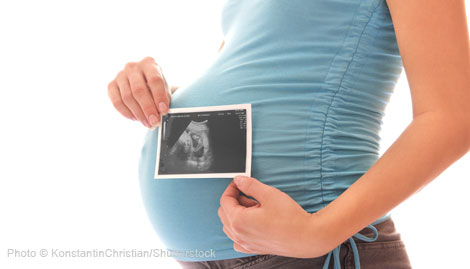|

Keeping Ultrasound in its Place
By Wendy Priesnitz
For many parents-to-be, one of the frustrating aspects of pregnancy is the lack of a window into their unborn child’s world. There is a technological fix for that, in the form of ultrasound or sonograms. First used in obstetrics in the middle of the twentieth century, they are now a routine part of prenatal treatment and pregnancy scans can be performed to detect developmental defects before birth.
In recent years, some clinics are offering ultrasound scans without a doctor’s order in order to determine babies’ gender and to create keepsake photos and even 3-D movies of fetal development. This non-medical practice is being discouraged by governments and medical associations.
The U.S. FDA says that ultrasound heats tissues slightly, and ultrasounds can also produce very small bubbles in some tissues, which is called cavitation. “The long-term effects of tissue heating and cavitation are not known. Therefore, ultrasound scans should be done only when there is a medical need,” the agency advises. It also says that ultrasounds administered by untrained technicians might reveal a complication or anomaly that is misinterpreted.
Research interest in this topic is increasing. A study was published online in September of 2016 in the journal Autism Research. The authors, led by Pierre D. Mourad, PhD, University of Washington, Seattle, reported that early prenatal diagnostic ultrasound has been linked to variability in symptoms of autism spectrum disorder (ASD) in children with specific genetic vulnerabilities. The authors note that these results “add weight to ongoing concerns” expressed by the US Food and Drug Administration (FDA) about the nonmedical use of diagnostic ultrasound during pregnancy.
Several organizations have also released statements regarding keepsake ultrasound.
The European Committee for Medical Ultrasound has said: “The embryonic period is known to be particularly sensitive to any external influences. Until further scientific information is available, investigations should be carried out with careful control of output levels and exposure times. With increasing mineralization of the fetal bone as the fetus develops, the possibility of heating fetal bone increases. The user should prudently limit exposure of critical structures such as the fetal skull or spine during Doppler studies (a type of ultrasound that detects movement, direction and speed, such as fetal heartbeat).”
The American Pregnancy Association states: “The ultrasound is a non-invasive procedure that, when used properly, has not demonstrated fetal harm. However, the long term effects of repeated and/or lengthy ultrasound exposures on the fetus are not fully known.”
The Society of Obstetricians and Gynaecologists of Canada (SOGC) and the Canadian Association of Radiologists issued a warning against “entertainment” ultrasounds in a joint policy statement, warning that every ultrasound involves exposes the fetus to “targeted energy,” and carries a theoretical risk of some harm.
So it is probably safer to keep that window closed and use your imagination until birth.
Wendy Priesnitz is Natural Life Magazine's editor. She has been a journalist for over forty years and is the author of thirteen books.
|

